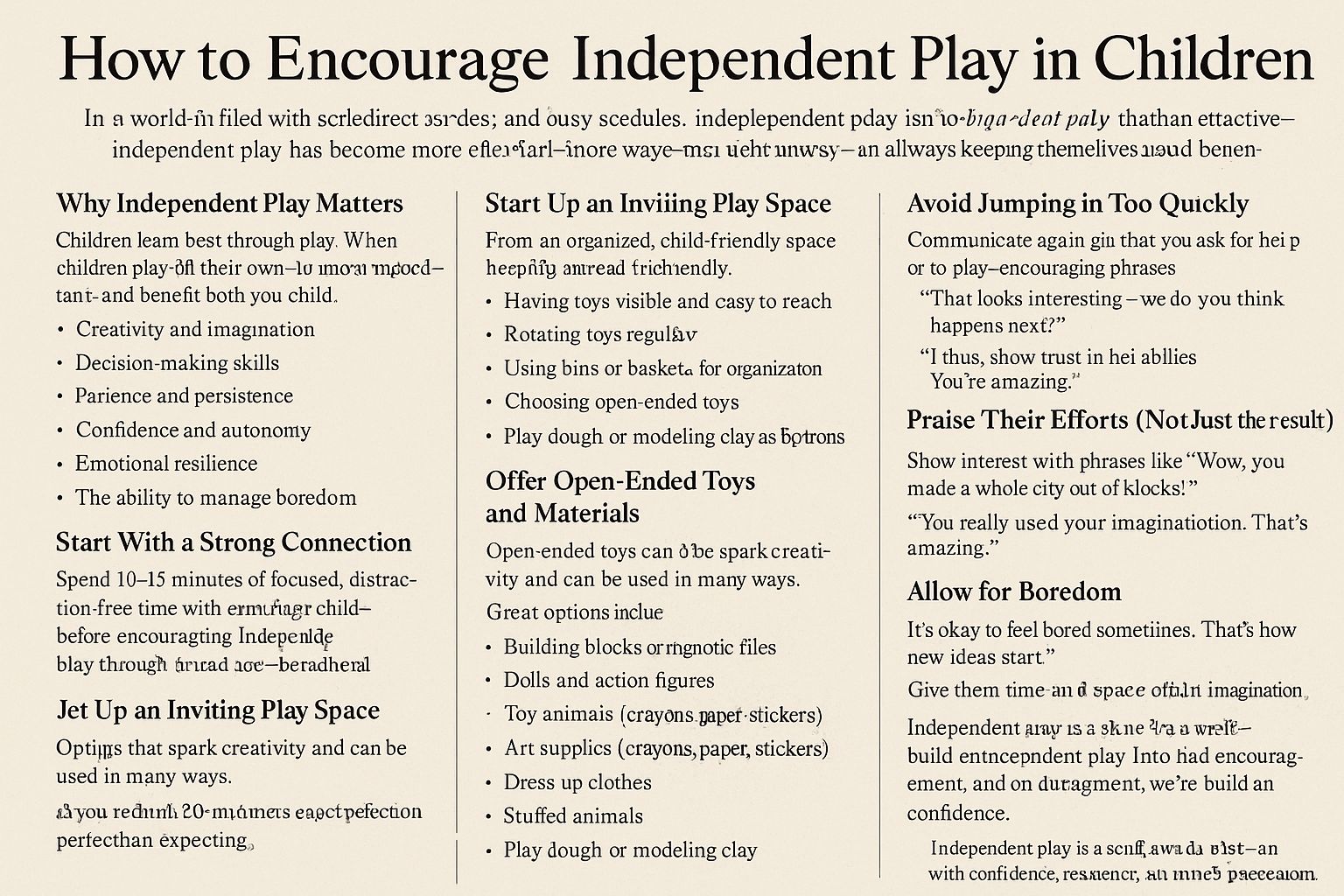In a world filled with screens, constant stimulation, and busy schedules, independent play has become more important—and more overlooked—than ever. But when children play on their own, they’re not just keeping themselves occupied. They’re developing imagination, problem-solving skills, confidence, focus, and emotional regulation.
Independent play is not about leaving your child alone for hours—it’s about fostering their ability to enjoy and create in their own space and time, without always needing adult direction.
Here’s how to encourage independent play in healthy, supportive ways that benefit both your child and your family.
Why Independent Play Matters
Children learn best through play. When that play is self-directed, they’re in charge of the ideas, decisions, and actions. That builds:
- Creativity and imagination
- Decision-making skills
- Patience and persistence
- Confidence and autonomy
- Emotional resilience
- The ability to manage boredom
Independent play also allows parents time to rest, work, or handle tasks without constant supervision—creating more balance in the home.
Start With a Strong Connection
Before encouraging your child to play independently, make sure their emotional cup is full. Children are more willing to explore on their own when they feel secure and connected to you.
Spend 10–15 minutes of focused, distraction-free time with them beforehand. This could be reading, cuddling, playing together, or just talking. Once they’ve felt your presence and attention, they’re more likely to feel safe and content to play on their own for a while.
Set Up an Inviting Play Space
An organized, accessible space encourages independent play. It doesn’t need to be big or expensive—it just needs to be child-friendly.
Tips for creating a great play environment:
- Keep toys visible and easy to reach
- Rotate toys regularly to keep interest fresh
- Use bins or baskets to organize by type (blocks, animals, art supplies)
- Choose open-ended toys like building blocks, dolls, play kitchen sets, or pretend tools
- Minimize noisy, flashy, or overly stimulating toys
Less clutter and more thoughtful choices lead to deeper, more engaged play.
Offer Open-Ended Toys and Materials
Open-ended toys don’t have one right way to play—they spark creativity and can be used in many ways.
Great options include:
- Building blocks or magnetic tiles
- Dolls and action figures
- Toy animals and cars
- Art supplies (crayons, paper, stickers)
- Dress-up clothes
- Stuffed animals
- Play dough or modeling clay
These tools allow your child to create their own stories, solve problems, and explore ideas at their own pace.
Set Realistic Expectations
If your child isn’t used to playing alone, it won’t happen instantly. Start small and build up.
- For toddlers: 5–10 minutes may be enough at first
- For preschoolers: aim for 15–30 minutes
- For older children: 30+ minutes is possible with practice
Celebrate progress rather than expecting perfection. Your child’s ability to play independently will grow with time and encouragement.
Use Gentle Boundaries
Let your child know that you’re nearby, but they don’t need your constant attention.
You can say:
- “I’m going to finish this task, and you can play here while I do that.”
- “I love watching your play, but I’m going to step away so you can keep imagining on your own.”
- “I’ll check back with you in 10 minutes.”
This builds confidence and teaches your child that it’s okay to be alone while still feeling safe and supported.
Avoid Jumping in Too Quickly
If your child calls for help or asks you to play, resist the urge to immediately take over. Instead, encourage their independence.
Try:
- “That looks interesting—what do you think happens next?”
- “You’ve got great ideas! I want to see what you come up with.”
- “Can you show me what you created when you’re done?”
By showing trust in their abilities, you build their confidence in managing their own play.
Create a Consistent Routine
Children do best with predictability. Include independent play as a regular part of the day, so it becomes expected and familiar.
For example:
- After breakfast: 20 minutes of solo play while you clean up
- After nap: quiet independent play with books or puzzles
- Before dinner: open-ended play while you cook
Consistency helps your child understand that independent play is a normal and positive part of daily life.
Praise Their Efforts (Not Just the Result)
When your child finishes a solo play session, show interest in what they did.
Say things like:
- “Wow, you made a whole city out of blocks!”
- “Tell me about this drawing—what’s happening here?”
- “You really used your imagination. That’s amazing.”
Focus on their effort and creativity, not just the final product. This reinforces their sense of pride and joy in playing independently.
Allow for Boredom
Boredom isn’t a problem—it’s the beginning of creativity. If your child says, “I’m bored,” avoid rushing to entertain them.
Instead, say:
- “It’s okay to feel bored sometimes. That’s how new ideas start.”
- “What could you do with what’s around you?”
- “Do you want to look through your toy bin for ideas?”
Give them time and space. Often, a little boredom is all it takes for imagination to kick in.
Independent Play Is a Skill—And a Gift
Encouraging independent play isn’t about leaving your child alone—it’s about teaching them how to enjoy their own company, think creatively, and trust themselves.
With the right environment, a little practice, and lots of encouragement, your child will learn to explore, imagine, and create without constant input. And in doing so, they’ll build not just play skills—but confidence, resilience, and inner peace.
